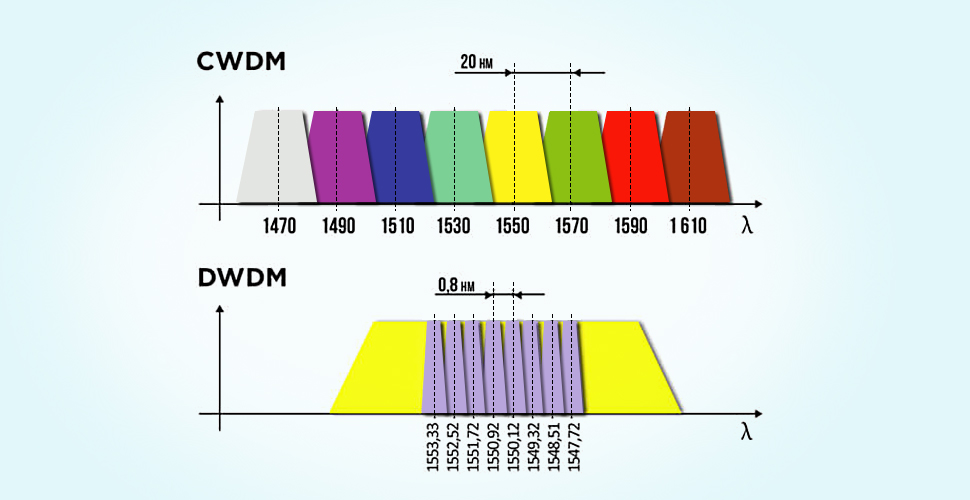CWDM vs DWDM: What’s the Difference?
When dealing with OTN (Optical Transport Network), there are two main types of Wavelength Division Multiplexing (WDM) systems: Coarse Wavelength Division Multiplexing (CWDM) and Dense Wavelength Division Multiplexing (DWDM). As two modern WDM technologies, they are both used for increasing the bandwidth of fiber by combining optical signals of different wavelengths on one strand of fiber. But CWDM vs DWDM, what are their differences?
WDM, CWDM and DWDM Wiki
To better understand the difference between CWDM and DWDM, we’d better get to know what’s WDM, CWDM, and DWDM in the first place.
What’s WDM?
WDM is a technology for transporting large amounts of data between sites. It increases bandwidth by allowing different data streams to be sent simultaneously over a single optical fiber network. In this way, WDM maximizes the utilization of fiber and helps to optimize network investments.
What’s CWDM and DWDM?
As mentioned above, CWDM and DWDM are two technologies developed based on WDM, but with different wavelength patterns and applications. CWDM is a flexible technology that can be deployed on most types of fiber networks. It is typically deployed in point-to-point topology in enterprise networks and telecom access networks. While DWDM is viewed as an option for the metropolitan network. Now it is also used for interconnecting data centers and for financial services networks and is often deployed in a ring topology.
CWDM vs DWDM, What Are Their Differences?
CWDM and DWDM are both effective methods to solve the increasing bandwidth capacity of information transmission at present. But they differ from each other in many aspects. Below parts will introduce some differences between CWDM and DWDM systems.
CWDM vs DWDM: Channel Spacing
The channel spacing is defined to be the nominal difference in frequency or wavelength between two adjacent optical channels. CWDM has a wider spacing than DWDM. It is able to transport up to 18 CWDM wavelengths with a channel spacing of 20nm in the spectrum grid from 1271nm to 1611nm. DWDM can carry 40, 80, or up to 160 wavelengths with a narrower spacing of 0.8/0.4nm (100 GHz/50 GHz grid). Its wavelengths are from 1525nm to 1565nm (C band) and 1570nm to 1610nm (L band).

CWDM vs DWDM: Transmission Distance
Since DWDM wavelengths are highly integrated with the fiber during light transmission, DWDM is able to reach a longer distance than CWDM. Unlike the DWDM system, CWDM is unable to travel unlimited distances. The maximum reach of CWDM is about 160 km. While an amplified DWDM system can go much further.
CWDM vs DWDM: Modulation Laser
CWDM system uses the uncooled laser while the DWDM system uses the cooling laser. Cooling laser adopts temperature tuning which ensures better performance, higher safety, and longer lifespan of the DWDM system. But it also consumes more power than the electronic tuning uncooled laser used by a CWDM system.
CWDM vs DWDM: Cost
Because the range of temperature distribution is nonuniform in a very wide wavelength, so the temperature tuning is very difficult to realize, thus using the cooling laser technique increases the cost of the DWDM system. Furthermore, the DWDM devices are typically four or five times more expensive than that of a CWDM system. However, the price of a DWDM transceiver is about 20-25% less than a CWDM transceiver on account of the popularization of DWDM.
CWDM vs DWDM: Advantages and Disadvantages
As mentioned above, the primary difference between DWDM and CWDM is the channel spacing (CWDM has almost 100 times wider channel spacing). This makes CWDM a simpler technology, resulting in advantages and disadvantages of the different systems with regard to cost, performance, and so on.
CWDM Advantages and Disadvantages
| CWDM Advantages | CWDM Disadvantages |
|---|---|
|
|
DWDM Advantages and Disadvantages
| DWDM Advantages | DWDM Disadvantages |
|---|---|
|
|
CWDM vs DWDM, Which Do You Prefer?
The tremendous demand for more bandwidth has triggered the DWDM's development, which makes it more favored in the market. And it has experienced great advancement in cost reduction. However, CWDM still has the price advantage for connection rates below 10G and for short distances. With low data rates, it is currently more feasible. In this way, CWDM and DWDM each will provide a unique “fit” in the OTN network, and will complement rather than replace each other in the future.
You might be interested in
Email Address

-
PoE vs PoE+ vs PoE++ Switch: How to Choose?
Mar 16, 2023














